Viable Use of Tire Pyrolysis Oil as an Additive to Conventional Motor Oil: A Tribological and Physical Study
Abstract
:1. Introduction
2. Materials and Experimental Methods
2.1. Samples Preparation
2.2. Characterization Methods
3. Results and Discussion
3.1. Elemental Composition and FTIR Analysis
3.2. Thermal Stability
3.3. Rheological Analysis
3.4. Wettability and Tribology
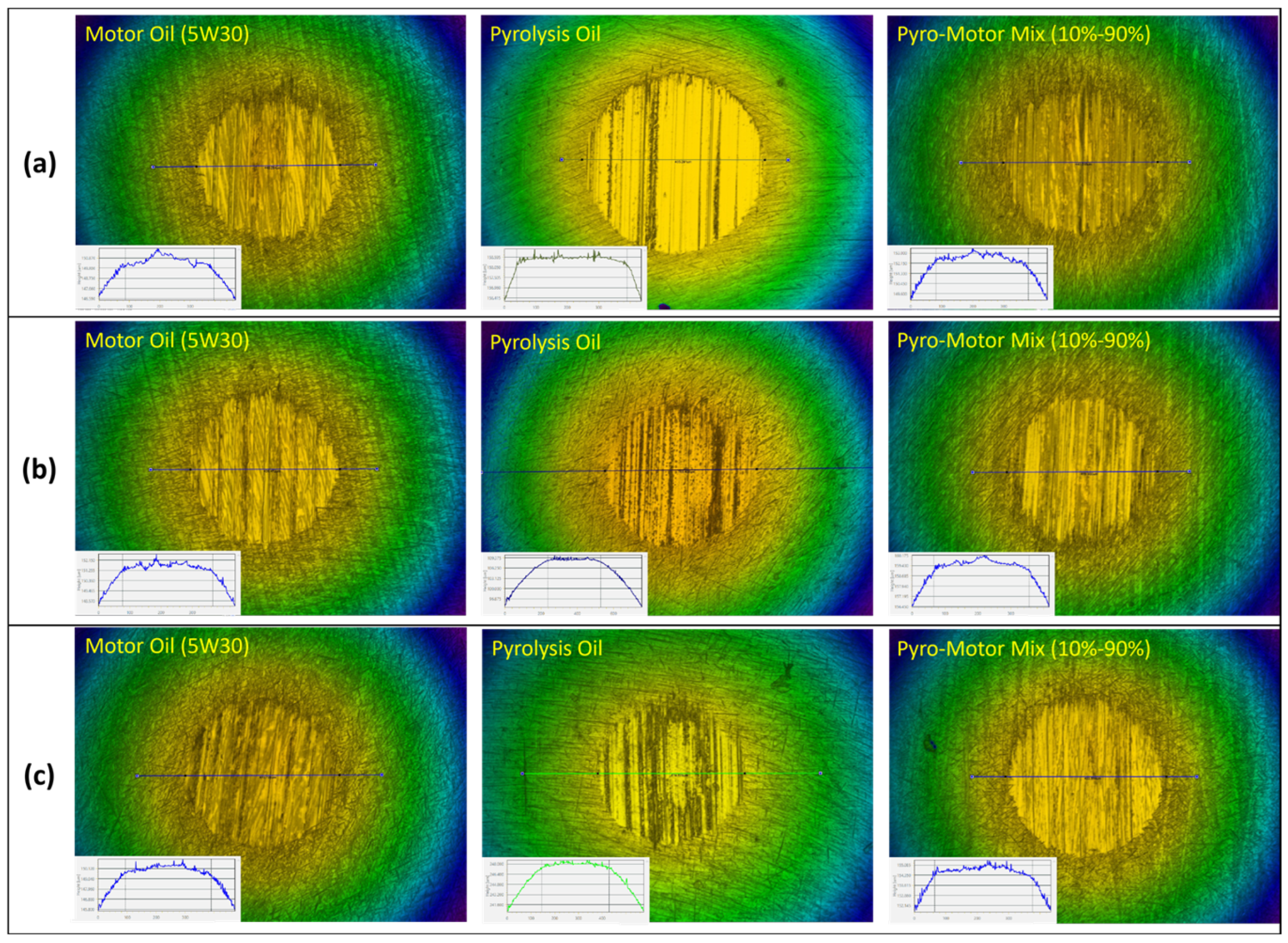
3.5. Statistical and Regression Analysis
3.6. Remarks on Environmental and Economic Impact
4. Conclusions
Author Contributions
Funding
Data Availability Statement
Acknowledgments
Conflicts of Interest
References
- Kupareva, A.; Mäki-Arvela, P.; Grénman, H.; Eränen, K.; Sjöholm, R.; Reunanen, M.; Murzin, D.Y. Chemical characterization of lube oils. Energy Fuels 2013, 27, 27–34. [Google Scholar] [CrossRef]
- Graziano, D.; Daniels, E. Assessment of Opportunities to Increase the Recovery and Recycling Rates of Waste Oils; Argonne National Lab. (ANL): Argonne, IL, USA, 1995. [Google Scholar]
- Kupareva, A.; Mäki-Arvela, P.; Murzin, D.Y. Technology for Rerefining Used Lube Oils Applied in Europe: A Review. J. Chem. Technol. Biotechnol. 2013, 88, 1780–1793. [Google Scholar] [CrossRef]
- Kajdas, C. Re-Refined Base Oils: Quality and Ecology. In Proceedings of the 4th European Rerefining Congress, Brussels, Belgium, 17 November 2009. [Google Scholar]
- Dutta, S. Middle East lubricant suppliers seek market diversification: Expansion into new industrial sectors reduces dependence on crude oil. Tribol. Lubr. Technol. 2018, 74, 18. [Google Scholar]
- Nagy, G.; Szabó, L.; Baladincz, J. Possibilities for processing of used lubricating oils-part 2. MOL Sci. Mag. 2010, 2, 66–72. [Google Scholar]
- Emma, A.F.; Alangar, S.; Yadav, A.K. Extraction and characterization of coffee husk biodiesel and investigation of its effect on performance, combustion, and emission characteristics in a diesel engine. Energy Convers. Manag. X 2022, 14, 100214. [Google Scholar] [CrossRef]
- Januszewicz, K.; Hunicz, J.; Kazimierski, P.; Rybak, A.; Suchocki, T.; Duda, K.; Mikulski, M. An experimental assessment on a diesel engine powered by blends of waste-plastic-derived pyrolysis oil with diesel. Energy 2023, 281, 128330. [Google Scholar] [CrossRef]
- Al-Salem, S.M.; Antelava, A.; Constantinou, A.; Manos, G.; Dutta, A. A review on thermal and catalytic pyrolysis of plastic solid waste (PSW). J. Environ. Manag. 2017, 197, 177–198. [Google Scholar] [CrossRef]
- Antelava, A.; Damilos, S.; Hafeez, S.; Manos, G.; Al-Salem, S.M.; Sharma, B.K.; Kohli, K.; Constantinou, A. Plastic solid waste (PSW) in the context of life cycle assessment (LCA) and sustainable management. Environ. Manag. 2019, 64, 230–244. [Google Scholar] [CrossRef]
- Williams, P.T. Pyrolysis of waste tyres: A review. Waste Manag. 2013, 33, 1714–1728. [Google Scholar] [CrossRef]
- Gehrke, I.; Schläfle, S.; Bertling, R.; Öz, M.; Gregory, K. Mitigation measures to reduce tire and road wear particles. Sci. Total Environ. 2023, 906, 166537. [Google Scholar] [CrossRef]
- Zerin, N.; Rasul, M.; Jahirul, M.; Sayem, A. End-of-life tyre conversion to energy: A review on pyrolysis and activated carbon production processes and their challenges. Sci. Total Environ. 2023, 905, 166981. [Google Scholar] [CrossRef] [PubMed]
- Al-Salem, S. Valorisation of end of life tyres (ELTs) in a newly developed pyrolysis fixed-bed batch process. Process Saf. Environ. Prot. 2020, 138, 167–175. [Google Scholar] [CrossRef]
- Zhang, G.; Chen, F.; Zhang, Y.; Zhao, L.; Chen, J.; Cao, L.; Gao, J.; Xu, C. Properties and utilization of waste tire pyrolysis oil: A mini review. Fuel Process. Technol. 2021, 211, 106582. [Google Scholar] [CrossRef]
- Hutchings, I.; Shipway, P. Tribology: Friction and Wear of Engineering Materials; Butterworth-Heinemann: Oxford, UK, 2017. [Google Scholar]
- Holmberg, K.; Erdemir, A. The impact of tribology on energy use and CO2 emission globally and in combustion engine and electric cars. Tribol. Int. 2019, 135, 389–396. [Google Scholar] [CrossRef]
- Tonk, R. The science and technology of using nano-materials in engine oil as a lubricant additives. Mater. Today Proc. 2021, 37, 3475–3479. [Google Scholar] [CrossRef]
- Gemsprim, M.S.; Babu, N.; Udhayakumar, S. Tribological evaluation of vegetable oil-based lubricant blends. Mater. Today Proc. 2021, 37, 2660–2665. [Google Scholar] [CrossRef]
- Alazemi, A.A.; Alajmi, A.F.; Al-Salem, S.M. Investigation of Chemical, Physical, and Tribological Properties of Pyrolysis Oil Derived from End-of-Life Tires (ELTs) against Conventional Engine Oil. Lubricants 2024, 12, 188. [Google Scholar] [CrossRef]
- Decote, P.A.; Negris, L.; Simonassi, P.; Druzian, G.T.; Flores, E.M.; Vicente, M.A.; Santos, M.F. Quality analysis of oil recovered from used locomotive engine oil using ultrasound-assisted solvent extraction. Chem. Eng. Res. Des. 2023, 197, 603–616. [Google Scholar] [CrossRef]
- Alazemi, A.A.; Alzubi, F.G.; Alhazza, A.; Dysart, A.; Pol, V.G. Rheological and wettability properties of engine oil with a submicron spherical carbon particle lubricant mixture. Int. J. Automot. Technol. 2020, 21, 1475–1482. [Google Scholar] [CrossRef]
- Pfeiffer, P.; Ronai, B.; Vorlaufer, G.; Dörr, N.; Filzmoser, P. Weighted LASSO variable selection for the analysis of FTIR spectra applied to the prediction of engine oil degradation. Chemom. Intell. Lab. Syst. 2022, 228, 104617. [Google Scholar] [CrossRef]
- Aberoumand, S.; Jafarimoghaddam, A. Experimental study on synthesis, stability, thermal conductivity and viscosity of Cu–engine oil nanofluid. J. Taiwan Inst. Chem. Eng. 2017, 71, 315–322. [Google Scholar] [CrossRef]
- Alazemi, A.A.; Etacheri, V.; Dysart, A.D.; Stacke, L.-E.; Pol, V.G.; Sadeghi, F. Ultrasmooth submicrometer carbon spheres as lubricant additives for friction and wear reduction. ACS Appl. Mater. Interfaces 2015, 7, 5514–5521. [Google Scholar] [CrossRef] [PubMed]
- Stankovikj, F.; Tran, C.-C.; Kaliaguine, S.; Olarte, M.V.; Garcia-Perez, M. Evolution of functional groups during pyrolysis oil upgrading. Energy Fuels 2017, 31, 8300–8316. [Google Scholar] [CrossRef]
- González, J.F.; Encinar, J.M.; Canito, J.L.; Rodríguez, J.J. Pyrolysis of automobile tyre waste. Influence of operating variables and kinetics study. J. Anal. Appl. Pyrolysis 2001, 58, 667–683. [Google Scholar] [CrossRef]
- Menares, T.; Herrera, J.; Romero, R.; Osorio, P.; Arteaga-Pérez, L.E. Waste tires pyrolysis kinetics and reaction mechanisms explained by TGA and Py-GC/MS under kinetically-controlled regime. Waste Manag. 2020, 102, 21–29. [Google Scholar] [CrossRef]
- Kadhim, A.; Al-Amiery, A. X-ray fluorescence of copper, nickle and zinc nanoparticles in motor oil prepared by laser treatment. J. Adv. Res. Fluid Mech. Therm. Sci. 2021, 83, 178–185. [Google Scholar] [CrossRef]
- Abnisa, F.; Daud, W.M.A.W.; Sahu, J.N. Pyrolysis of mixtures of palm shell and polystyrene: An optional method to produce a high-grade of pyrolysis oil. Environ. Prog. Sustain. Energy 2014, 33, 1026–1033. [Google Scholar] [CrossRef]
- Osayi, J.I.; Iyuke, S.; Daramola, M.O.; Osifo, P.; Van Der Walt, I.J.; Ogbeide, S.E. Evaluation of pyrolytic oil from used tires and natural rubber (Hevea brasiliensis). Chem. Eng. Commun. 2018, 205, 805–821. [Google Scholar] [CrossRef]
- Mishra, A.; Kumari, U.; Turlapati, V.Y.; Siddiqi, H.; Meikap, B. Extensive thermogravimetric and thermo-kinetic study of waste motor oil based on iso-conversional methods. Energy Convers. Manag. 2020, 221, 113194. [Google Scholar] [CrossRef]
- Mishra, A.; Siddiqi, H.; Sonowal, M.; Chatterjee, A.; Maiti, P.; Meikap, B. A cumulative study on pyrolysis of waste motor oil exploring the design and development of a fixed-bed laboratory scale setup with emphasis on process parameter optimization, COMSOL simulation and preliminary risk assessment. Process Saf. Environ. Prot. 2024, 185, 1219–1231. [Google Scholar] [CrossRef]
- Williams, P.T.; Besler, S.; Taylor, D.T. The pyrolysis of scrap automotive tyres: The influence of temperature and heating rate on product composition. Fuel 1990, 69, 1474–1482. [Google Scholar] [CrossRef]
- Chandran, M.; Rajamamundi, P.; Kit, A.C. Tire oil from waste tire scraps using novel catalysts of manufacturing sand (M Sand) and TiO2: Production and FTIR analysis. Energy Sources Part A Recovery Util. Environ. Eff. 2017, 39, 1928–1934. [Google Scholar] [CrossRef]
- Kalam, M.; Masjuki, H.; Cho, H.M.; Mosarof, M.; Mahmud, I.; Chowdhury, M.A.; Zulkifli, N. Influences of thermal stability, and lubrication performance of biodegradable oil as an engine oil for improving the efficiency of heavy duty diesel engine. Fuel 2017, 196, 36–46. [Google Scholar] [CrossRef]
- Nik, W.W.; Ani, F.; Masjuki, H. Thermal stability evaluation of palm oil as energy transport media. Energy Convers. Manag. 2005, 46, 2198–2215. [Google Scholar] [CrossRef]
- Ruan, H.; Zhang, Y.; Li, S.; Yang, L.; Wang, C.; Wang, T.; Wang, Q. Effect of temperature on the friction and wear performance of porous oil-containing polyimide. Tribol. Int. 2021, 157, 106891. [Google Scholar] [CrossRef]
- ASTM G99-17; Standard Test Method for Wear Testing with a Pin-on-Disk Apparatus. ASTM International: West Conshohocken, PA, USA, 2017.
- Montgomery, D.C. Design and Analysis of Experiments; John Wiley & Sons: Hoboken, NJ, USA, 2017. [Google Scholar]
- Okoro, E.E.; Erivona, N.O.; Sanni, S.E.; Orodu, K.B.; Igwilo, K.C. Modification of waste tire pyrolytic oil as base fluid for synthetic lube oil blending and production: Waste tire utilization approach. J. Mater. Cycles Waste Manag. 2020, 22, 1258–1269. [Google Scholar] [CrossRef]
- Mokhtar, N.M.; Omar, R.; Idris, A. Microwave pyrolysis for conversion of materials to energy: A brief review. Energy Sources Part A Recovery Util. Environ. Eff. 2012, 34, 2104–2122. [Google Scholar] [CrossRef]
- Liu, L.; Cai, G.; Zhang, J.; Liu, X.; Liu, K. Evaluation of engineering properties and environmental effect of recycled waste tire-sand/soil in geotechnical engineering: A compressive review. Renew. Sustain. Energy Rev. 2020, 126, 109831. [Google Scholar] [CrossRef]
- Islam, M.; Nahian, M. Improvement of waste tire pyrolysis oil and performance test with diesel in CI Engine. J. Renew. Energy 2016, 2016, 5137247. [Google Scholar] [CrossRef]
- Sarkar, S.; Datta, D.; Deepak, K.S.; Mondal, B.K.; Das, B. Comprehensive investigation of various re-refining technologies of used lubricating oil: A review. J. Mater. Cycles Waste Manag. 2023, 25, 1935–1965. [Google Scholar] [CrossRef]

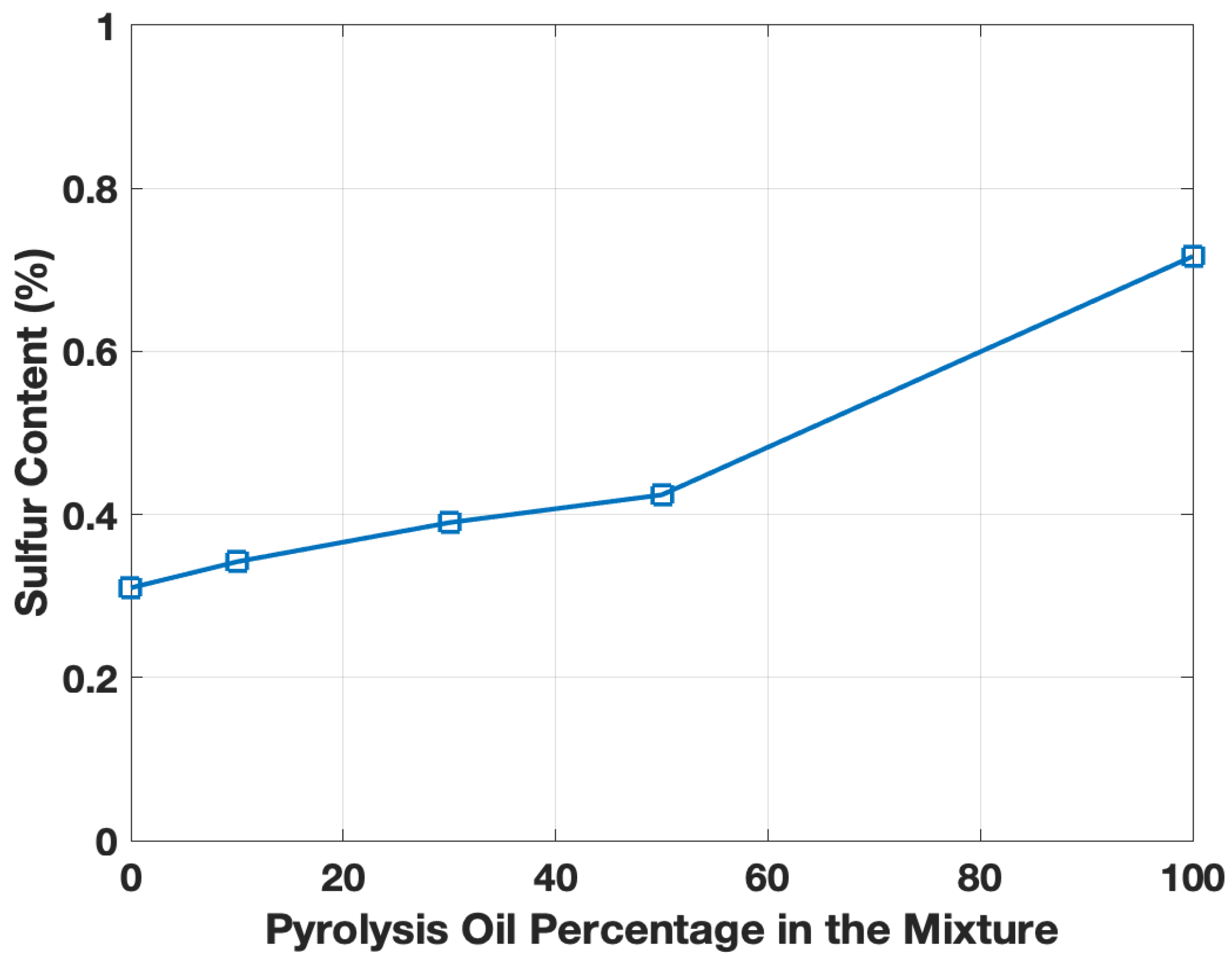



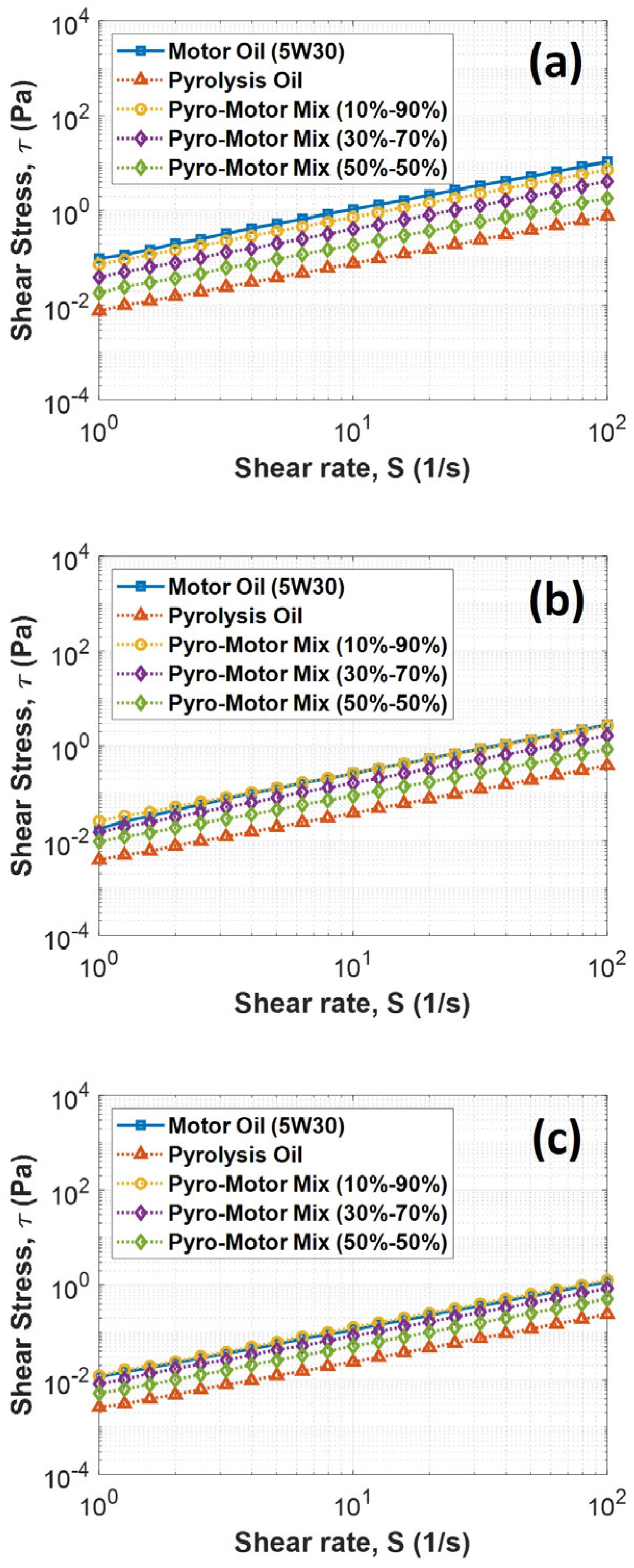
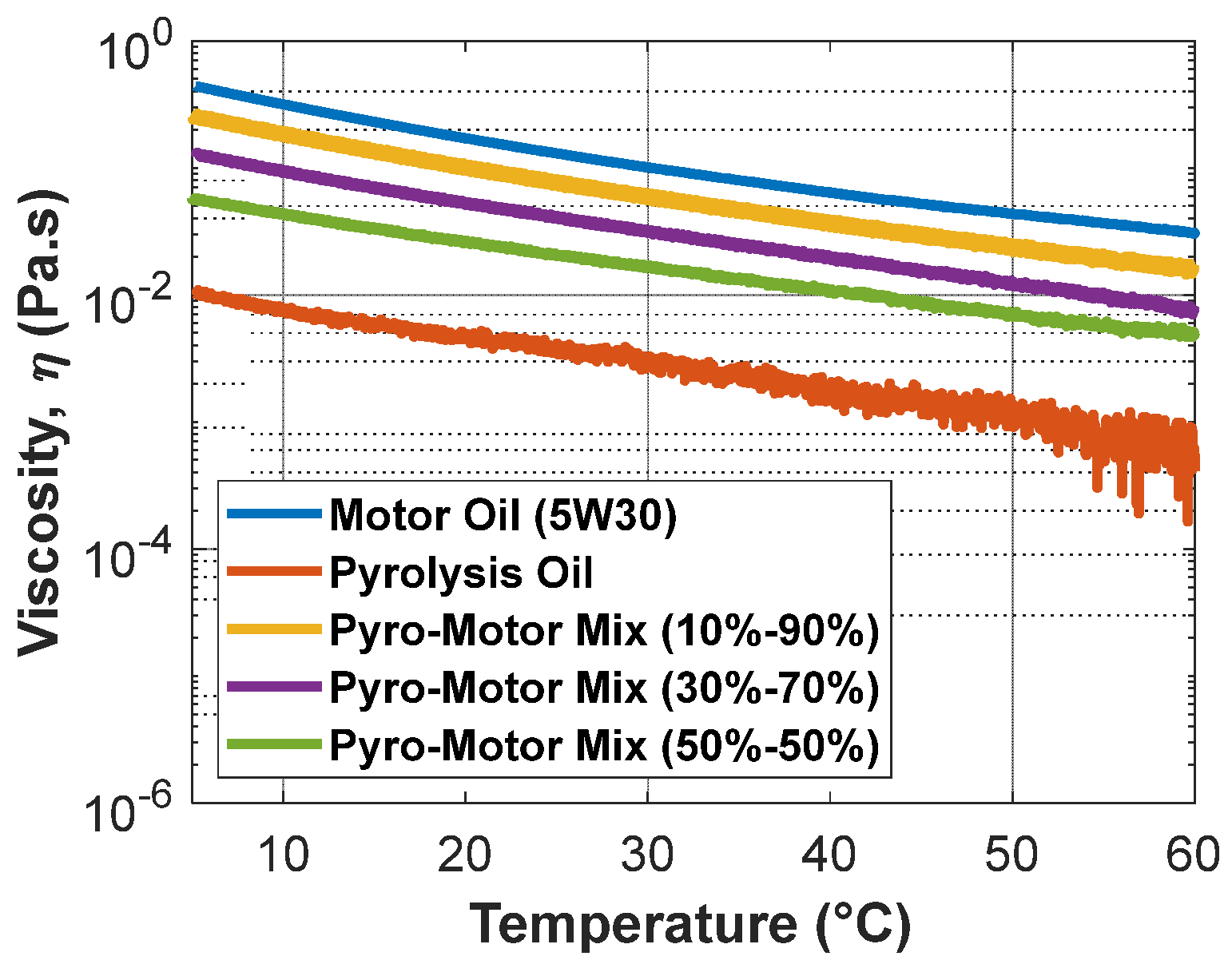
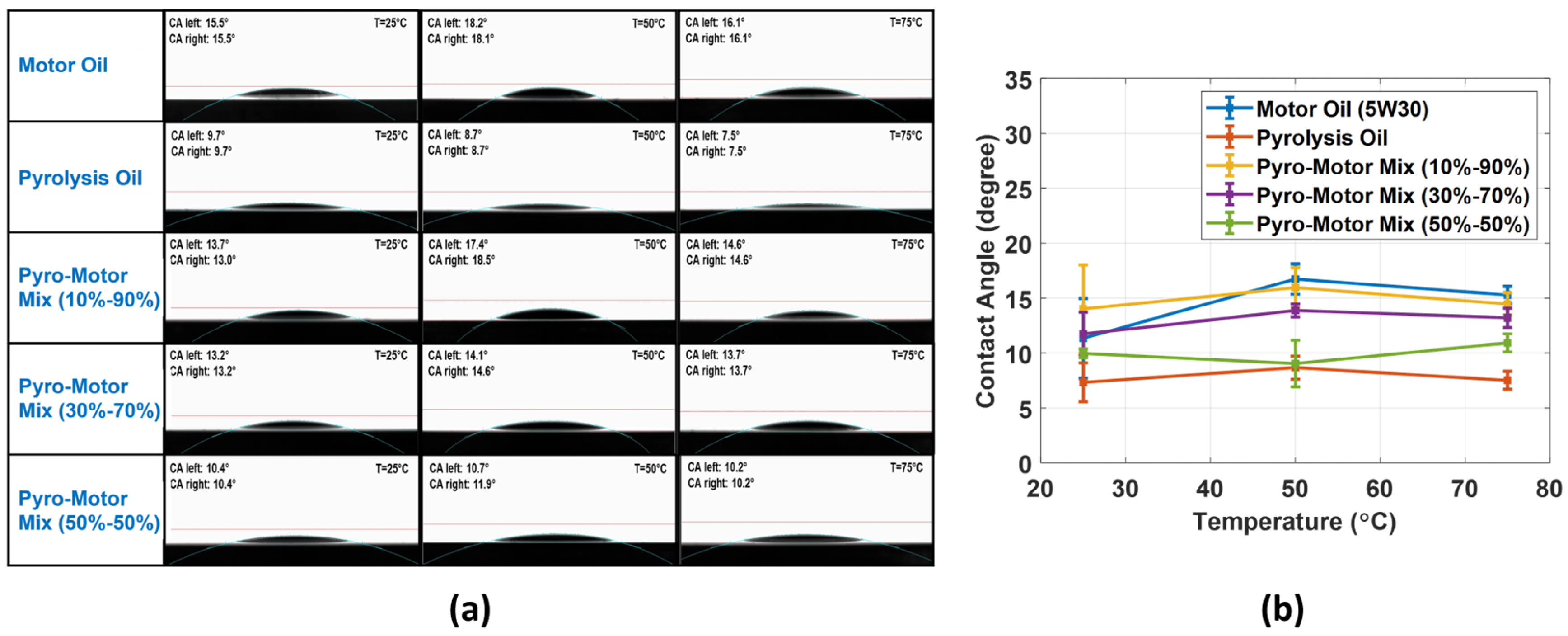


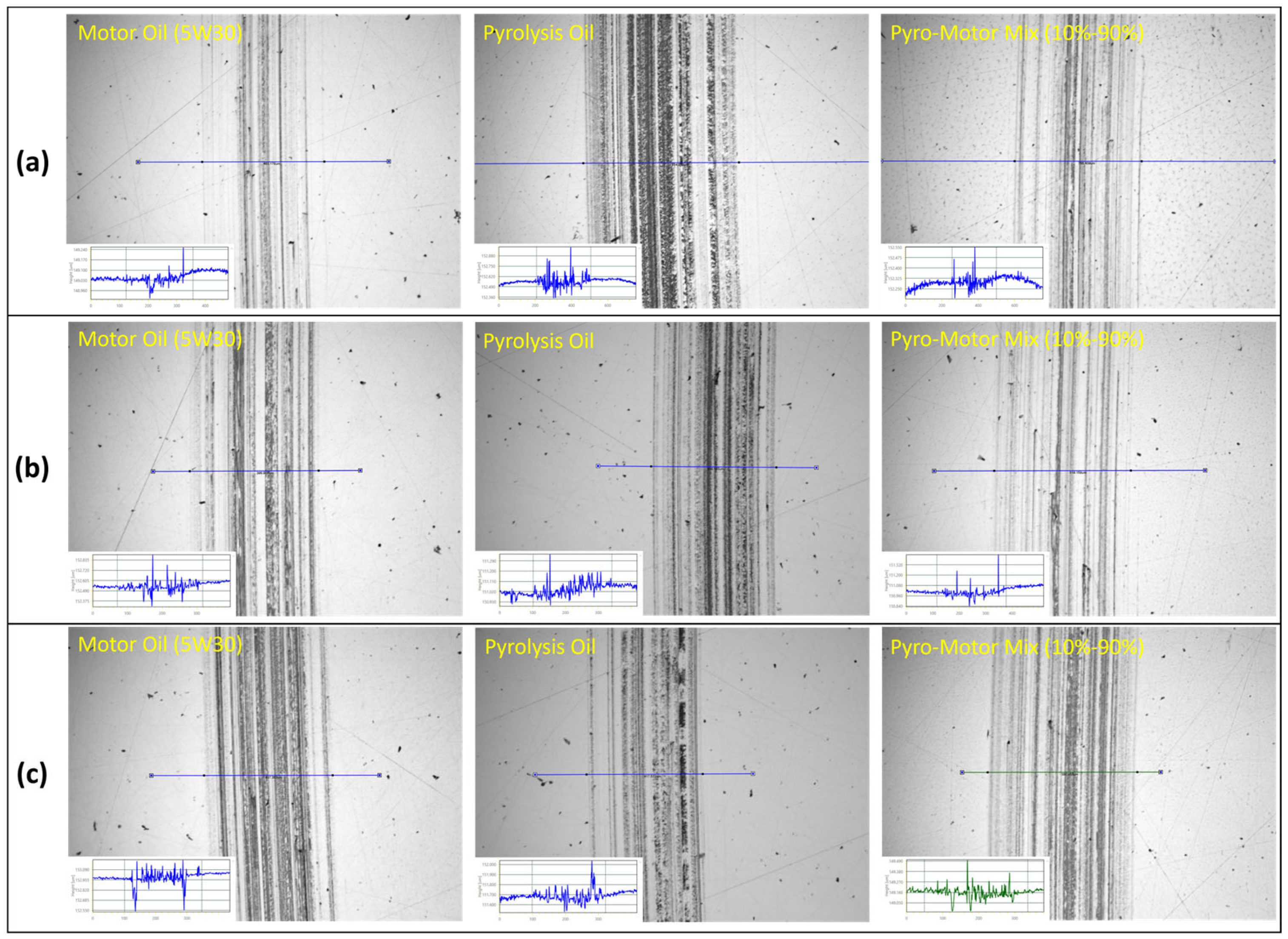

| Sample (wt./wt.%) | Nitrogen (N, %) | Carbon (C, %) | Hydrogen (H, %) | Sulfur (S, %) | Oxygen (O, %) |
|---|---|---|---|---|---|
| Motor Oil | 0.065 | 50.385 | 16.746 | 0.310 | 32.49 |
| ELT Pyro-Oil | 0.415 | 47.890 | 11.754 | 0.7165 | 39.22 |
| ELT Pyro-Oil/Motor Oil (10–90%) | 0.075 | 50.465 | 16.885 | 0.342 | 32.23 |
| ELT Pyro-Oil/Motor Oil (30–70%) | 0.165 | 51.575 | 14.740 | 0.390 | 33.13 |
| ELT Pyro-Oil/Motor Oil (50–50%) | 0.215 | 50.965 | 13.209 | 0.424 | 35.18 |
| No. | Element | Outcome (Mass%) | Det. Limit | El. Line | Intensity | w/o Normal |
|---|---|---|---|---|---|---|
| 1 | Si | 0.0000 | 0.01059 | Si-KA | 0.1744 | 0.0000 |
| 2 | P | 0.0601 | 0.00168 | P-KA | 9.2321 | 0.0601 |
| 3 | S | 0.5680 | 0.00150 | S-KA | 92.0354 | 0.5678 |
| 4 | Ca | 0.0131 | 0.00117 | Ca-KA | 1.8046 | 0.0131 |
| 5 | Br | 0.0005 | 0.00022 | Br-KA | 4.0943 | 0.0005 |
| 6 | C | 99.400 | 99.3585 |
| Parameter | Motor Oil | Pyro-Oil | 10–90% Mixture | 30–70% Mixture | 50–50% Mixture |
|---|---|---|---|---|---|
| Mass loss (%) | 96.6 | 98.1 | 97.0 | 97.1 | 97.7 |
| Onset temperature (°C) | 208 | 61 | 100 | 71 | 63 |
| Midpoint temperature (°C) | 326 | 211 | 311 | 303 | 281 |
| Maximum decomposition rate temperature (°C) | 340 | 233 | 327 | 328 | 324 |
| Standard Deviation | 0.0052 |
| Mean | 0.0910 |
| Coefficient of variance (C.V. %) | 5.70 |
| R2 | 0.9376 |
| Adjusted R2 | 0.9360 |
| Predicted R2 | 0.9341 |
| Adequate Precision | 79.0714 |
| Source | Sum of Squares | df | Mean Square | F-Value | p-Value | Results |
|---|---|---|---|---|---|---|
| Developed Model | 0.1382 | 9 | 0.0154 | 569.58 | <10−4 | significant |
| A-RPM | 0.0817 | 1 | 0.0817 | 3031.29 | <10−4 | significant |
| B-Temperature | 0.0006 | 1 | 0.0006 | 22.00 | <10−4 | significant |
| C-Pyro-Oil % | 0.0017 | 1 | 0.0017 | 63.53 | <10−4 | significant |
| AB | 0.0005 | 1 | 0.0005 | 17.17 | <10−4 | significant |
| AC | 0.0044 | 1 | 0.0044 | 164.90 | <10−4 | significant |
| BC | 2.236 × 10−7 | 1 | 2.236 × 10−7 | 0.0083 | 0.9275 | insignificant |
| A2 | 0.0030 | 1 | 0.0030 | 109.65 | <10−4 | significant |
| B2 | 0.0008 | 1 | 0.0008 | 27.87 | <10−4 | significant |
| C2 | 0.0005 | 1 | 0.0005 | 19.63 | <10−4 | significant |
| Residual | 0.0092 | 341 | 0.0000 | <10−4 | ||
| Cor Total | 0.1474 | 350 |
Disclaimer/Publisher’s Note: The statements, opinions and data contained in all publications are solely those of the individual author(s) and contributor(s) and not of MDPI and/or the editor(s). MDPI and/or the editor(s) disclaim responsibility for any injury to people or property resulting from any ideas, methods, instructions or products referred to in the content. |
© 2025 by the authors. Licensee MDPI, Basel, Switzerland. This article is an open access article distributed under the terms and conditions of the Creative Commons Attribution (CC BY) license (https://creativecommons.org/licenses/by/4.0/).
Share and Cite
Alazemi, A.A.; Alajmi, A.F.; Al-Salem, S.M. Viable Use of Tire Pyrolysis Oil as an Additive to Conventional Motor Oil: A Tribological and Physical Study. Lubricants 2025, 13, 64. https://doi.org/10.3390/lubricants13020064
Alazemi AA, Alajmi AF, Al-Salem SM. Viable Use of Tire Pyrolysis Oil as an Additive to Conventional Motor Oil: A Tribological and Physical Study. Lubricants. 2025; 13(2):64. https://doi.org/10.3390/lubricants13020064
Chicago/Turabian StyleAlazemi, Abdullah A., Abdullah F. Alajmi, and Sultan M. Al-Salem. 2025. "Viable Use of Tire Pyrolysis Oil as an Additive to Conventional Motor Oil: A Tribological and Physical Study" Lubricants 13, no. 2: 64. https://doi.org/10.3390/lubricants13020064
APA StyleAlazemi, A. A., Alajmi, A. F., & Al-Salem, S. M. (2025). Viable Use of Tire Pyrolysis Oil as an Additive to Conventional Motor Oil: A Tribological and Physical Study. Lubricants, 13(2), 64. https://doi.org/10.3390/lubricants13020064






